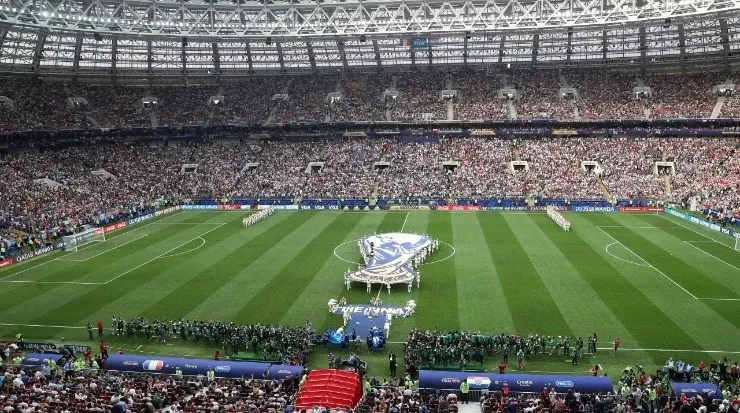Fervor for the FIFA World Cup is at its peak. And it’s not just Qatar 2022 that is being talked about recently, with the 32 national teams that will compete in it already announced. The conversation also includes the 2026 edition, whose 16 venues have been announced.
The joy generated by a FIFA World Cup is something that is shared. That is why every venue and every stadium that has the opportunity to host one or more matches of this tournament will have an indelible mark, which will give it a prestige that it did not have before.
Thus, the history and glory of each and every edition of the FIFA World Cup, soccer’s most prestigious tournament, has been spread throughout every venue and stadium. This is where the question arises: which have been the most generous editions so far? That is, those that have had the most host cities and stadiums? We will find out in the following lines.
Venues and stadiums in FIFA World Cup history
Qatar 2022 will open its doors to the world to host the 22nd edition of the World Cup. This in 92 years of life of this tournament. The first Cup of this nature in the Middle East faces its most stellar moment with 5 venues, in which 8 stadiums will be available to host the 64 matches that will comprise the tournament.
In total, and throughout the 21 editions of the FIFA World Cup already held, and one to be held at the end of 2022, there have been 167 venues and 190 different stadiums that have been the guardians of all the stories that this tournament has delivered.
The 2026 FIFA World Cup, the twenty-third edition of this tournament, already knows how many host cities and stadiums will host the 80 matches that will make it up (it will be the longest edition in history and with the largest number of teams included so far with 48 squads). Thus, there are 16 host cities in total: 11 in the United States, 3 in Mexico and 2 more in Canada, with the same number of stadiums.

Al Bayt Stadium, Qatar 2022. (Francois Nel/Getty Images)
FIFA World Cup editions with more venues and stadiums
Qatar 2022 will go down in history as the edition with the fewest venues and stadiums since Argentina 1978, when there were 5 venues and 6 stadiums to host the 38 matches held in that edition. The one to be held from November to December 2022 will consist of 64 matches and 32 teams, twice as many as in the edition won by Mario Kempes and company.
And on the other hand, it is evident that common sense indicates which has been the FIFA World Cup edition with the most host cities and stadiums in history: the only one, until 2026 Mexico-Canada-United States, with more than one host country, the one of 2002.

Stadium 974, Qatar 2022. (David Ramos/Getty Images)
Korea-Japan 2002:20 host cities and 20 stadiums
This edition of the FIFA World Cup is historic for being the first to be organized in two countries and the one with the most host cities and stadiums, with 20. The inaugural match was held at the Seoul World Cup Stadium and the final, in which Brazil was crowned, took place in Yokohama, Japan.

Yokohama International Stadium. (Tim De Waele/Getty Images)
Spain 1982: 14 host cities and 17 stadiums
A real novelty was the fact that Spain decided to break the previous record, which belonged to the Sweden 1958 edition, with such a large number of venues and stadiums. Among those chosen were Madrid and Barcelona with their imposing Santiago Bernabeu and Camp Nou.

Santiago Bernabeu, Spain 1982. (Central Press/Getty Images)
4 editions: 12 host cities and 12 stadiums
The most common number of host cities and stadiums in FIFA World Cup history. The first edition to do so was Sweden 1958. It took 42 years for it to be repeated, in Italy 1990. This behavior was later imitated by Germany 2006 and Brazil 2014. Three of the four times included countries that hosted the tournament for the second time.

Berlin Olympic Stadium, Germany 2006. (Michael Steele/Getty Images)
Russia 2018: 11 host cities and 12 stadiums
The Russians looked for a way to enter the history books and at least they succeeded in doing so by being one of the editions with the most venues and stadiums in the tournament. Although cities such as St. Petersburg played a leading role, the main role was always clear: Moscow was the venue for the inauguration and the final, in which France was crowned two-time world champion.

Luzhniki Stadium, Russia 2018. (Catherine Ivill/Getty Images)
Mexico 1986: 10 host cities and 12 stadiums
The nation of Hugo Sanchez, Rafael Marquez and Javier Chicharito Hernandez learned their lesson and doubled their previous bet. After hosting in 1970, Mexico stepped in for Colombia to host another World Cup just 16 years later, and did so with twice as many venues and more than twice as many stadiums.

Azteca Stadium, Mexico 1986. (Allsport/Getty Images/Hulton Archive)
France 1998: 10 host cities and 10 stadiums
The lesson is clear: a country that repeats as host of an edition of the World Cup has the desire to show more of its culture and people to the world. Sixty years after hosting its first World Cup, France once again had the honor and increased its quota of host cities, but not of stadiums.

Stade de France, France 1998. (Laurence Griffiths/Getty Images)





